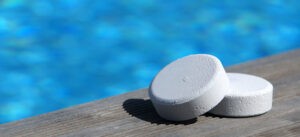Beware of high Cyanuric Acid when using Trichlor tablets in your swimming pool
February 21, 2017
This is an excellent post I found the web. Thanks to Majestic Pool Service for granting permission for the reprint. If you ever need pool service in Naples, FL give them a call!
– Just this winter, I have already run into several homeowners having trouble with spots on their finish starting to etch or show “mottling” aka pool plaster discoloration. It usually starts when the person calls me, asking for an opinion on the “stains that are starting to form” on their pool finish. In almost all of these cases, it is a homeowner doing their own pool care, so the first thing I start with is a full test of all of the major parameters, in regards to proper pool water chemistry.
What I find is that the people have extremely aggressive or corrosive water, and that they are all using Trichlor tablets in excessive amounts without any regard for the actual chemistry in the water.
 The problem with this is not excessive chlorination-
The problem with this is not excessive chlorination-
The problem is that they are overdosing their pool with several other elements and compounds that are found in each trichlor tablet, and these elements are the actual things that are causing the finish to etch.
For complicated problems with plaster and marcite pool finishes, more and more people are turning to the LSI, or Langelier Saturation Index, to determine what is really going on in pool water and to figure out how it may be affecting the finish or plaster. It is the best way to measure water in terms of hardness and softness.
Most often, when I test the water, the PH, TA, Calcium and temperature all are at levels that would lead to an ideal LSI calculation.
But this is without the presence of cyanuric acid (aka, “conditioner” or “stabilizer”). I find that most of these pools have been loaded up with so many trichlor tablets for a long enough period, that the pool owner has dissolved huge amounts of cyanuric acid into the pool (200PPM or higher !!! Ideal range should always be 80PPM or less!!!!) Often, I will have to dilute my drop test once or even twice to get an accurate reading, because the scale on my test comparator does not go high enough!!! Usually, at the same time, I walk out to the erosion feeder or chlorinator at the equipment and find 3″ trichlor tablets stacked inside, all the way to the top of the cylinder!!!!
When the high level of cyanuric acid in these pools is taken into account when measuring adjusted total Alkalinity, or entering it properly to get the true LSI, the result is a negative number on the LSI that is considered corrosive.
This link is a great calculator that a pool owner can quickly use to determine where they stand in the LSI. The ideal way to gather your parameters is with a drop test or an actual water sample. Either will allow you to get more precise numbers, rather than broad ranges indicated by a color coded test strip.
hint: most properly balanced pool water will have a TDS of 1500. If you have high cyanuric, you probably have an even higher TDS than that. If you have cyanuric over 100PPM, I would assume that you have at least 2000 TDS or higher) Salt systems or salt chlorination……even higher! Most pool stores with electronic testing can test your TDS or “total dissolved solids” along with everything else.
This is much more in-depth explantion of the role of cyanuric acid in pool water.
So what is the solution? Ease up on the trichlor tablets!!!! (and use liquid chlorine that doesn’t have all the additives). Too often, people use them as the only means of treating their pool water. They go to Costco or Sam’s, they buy a 50# bucket and start feeding.
If enough fresh water is added to the pool to keep pace with the amount of tablets that you are using, sometimes you will avoid overdoses. I know that in SW Florida, I most often find these situations during the dry season. The homeowner had to pile on the tabs during the summer (when it is hot, higher cyanuric is necessary, and there is excessive rainfall and chlorine demand), but they fail to put on the brakes when the winter months come and the weather becomes drier and more mild.
I recommend getting an accurate cyanuric acid reading from a professional on a regular basis. If your cyanuric acid is getting high, ask for “unstabilized” methods of chlorination. Examples: use sodium hypochlorite (liquid bleach), or calcium hypochlorite to shock, when necessary.
The only way to correct high cyanuric levels in the pool will be to dilute, or drain water and re-fill with fresh water. This is an expensive and much more inconvenient alternative to taking a few extra simple steps to make sure that you are using the right chemicals at the right times.
Reprinted with permission from: Majestic Pool Service, Naples, Florida
